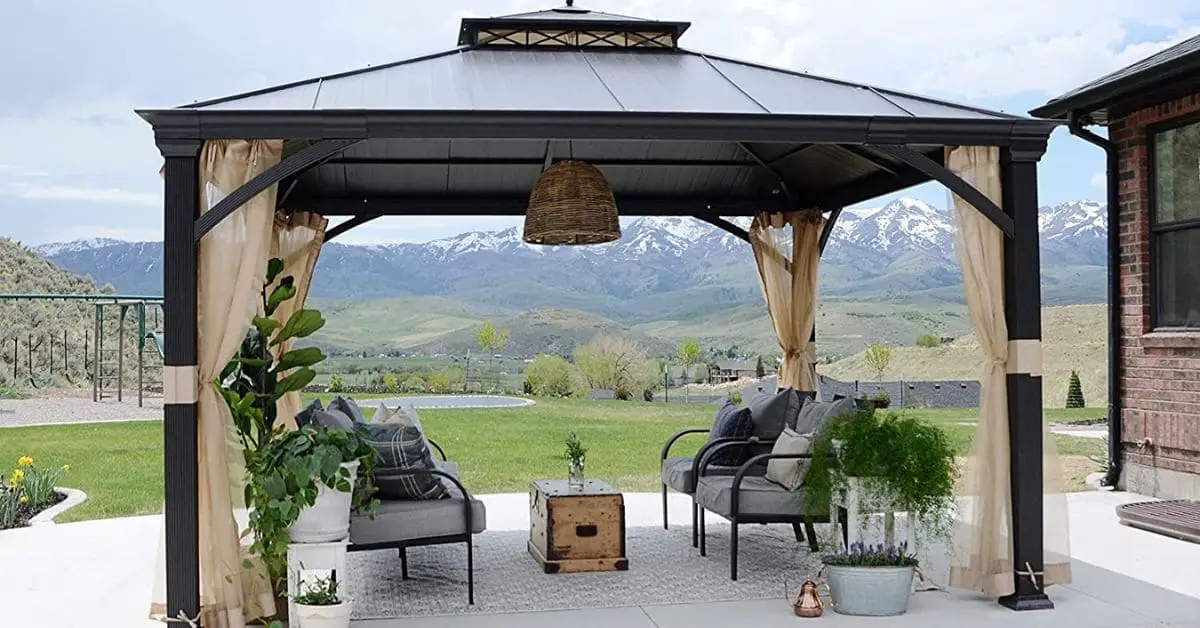A hard top gazebo is a famous outdoor structure that can provide shade, shelter, and a comfortable gathering space for family and friends.
It is made of sturdy materials such as aluminum, steel, or wood and features a solid roof that protects the elements.
If you’re considering buying a hard top gazebo, one crucial question that you may have is what its lifespan is.
The answer to this question can depend on several factors, including the quality of materials used, the climate in which it is installed, and the level of maintenance it receives.
In this article, we’ll explore these factors in more detail and provide you with an idea of what to expect regarding the lifespan of your hard-top gazebo.
Knowing this information can help you decide whether a hard top gazebo is the right choice for your outdoor space.
What is the lifespan of a hard top gazebo: A hardtop gazebo typically ranges from 10 to 20 years, depending on the quality of materials, maintenance, and exposure to weather conditions. Regular cleaning and protective measures can extend its longevity.
What is the lifespan of a hard top gazebo?
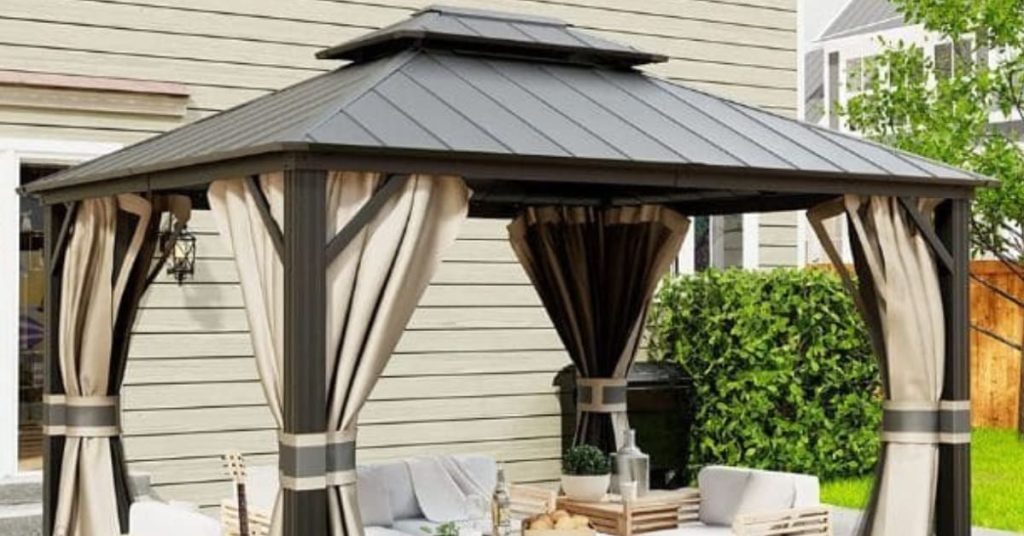
The lifespan of a hard top gazebo can vary based on the materials used to build it. Metal gazebos can last for around 10-15 years, polycarbonate gazebos can last for around 5-10 years, and wooden gazebos can last for around 5-15 years.
However, the lifespan of a gazebo can depend on other factors such as how well it is taken care of and how much sun exposure it gets.
If the gazebo is made from high-quality materials and receives proper maintenance, it may last longer than the average lifespan.
Factors that Affect the Lifespan of a Hard Top Gazebo
A hard top gazebo is a durable outdoor structure that can provide a comfortable space for outdoor gatherings and activities. However, like any outdoor structure, its lifespan can be influenced by various factors.
Understanding these factors can help you choose the right gazebo for your outdoor space and ensure that it lasts for as long as possible.
In this article, we’ll explore the factors that affect the lifespan of a hard top gazebo.
Material Used
The material used to construct a hard top gazebo is one of the most critical factors influencing its lifespan. Hard top gazebos can be made of various materials such as aluminum, steel, or wood. Each material has its unique advantages and disadvantages.
Aluminum gazebos are lightweight and rust-resistant. They require little maintenance, making them a popular choice for outdoor structures. They can last several years and even a lifetime with proper care and maintenance.
Steel gazebos are solid and sturdy, making them great for areas with heavy snow or wind loads. However, steel can rust if it is not correctly coated or painted. A well-maintained steel gazebo can last for many years.
Wooden gazebos are a popular choice for their natural beauty and warmth. However, they require more maintenance than other materials.
Regular sealing, staining, or painting is necessary to protect the wood from rot, pests, and weather damage. With proper maintenance, a wooden gazebo can last for decades.
Climate and Weather Conditions
The climate and weather conditions in your area can also affect the lifespan of your hard top gazebo. Your gazebo may be more susceptible to damage if you live in an area with extreme temperatures, strong winds, or heavy snow loads.
For example, if you live in an area with heavy snow loads, you may want to choose a gazebo with a steeper roof pitch.
This design will allow snow to slide off the roof instead of accumulating and potentially causing damage.
Strong winds can also be a concern. Gazebos with sturdy frames and well-secured roofing panels can better withstand high winds.
Wooden gazebos are more prone to rot and insect damage in areas with high humidity. Regular maintenance and treatment with wood preservatives can help prevent these issues.
Maintenance and Upkeep
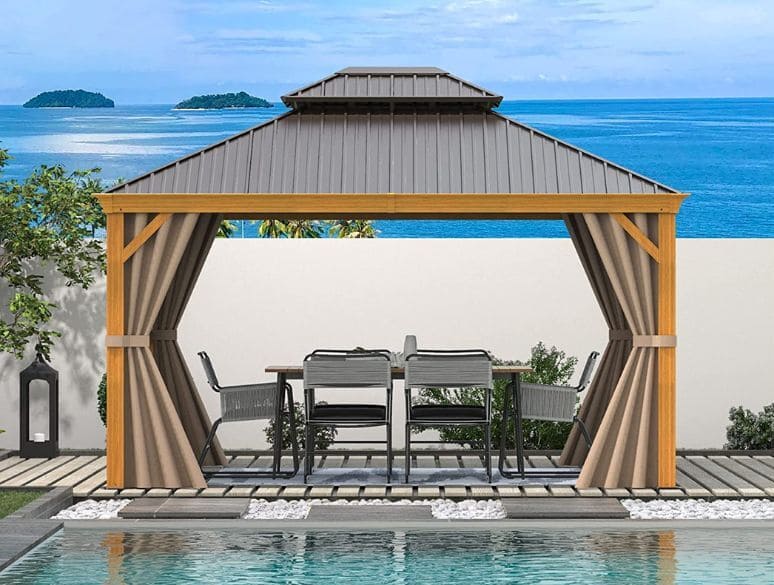
Regular maintenance and upkeep are essential for ensuring the longevity of your hard-top gazebo. Neglecting maintenance can cause minor problems to turn into more significant issues, reducing the lifespan of your gazebo.
The level of maintenance required will depend on the material used to construct your gazebo. For example, aluminum gazebos require minimal maintenance, while wooden gazebos require regular cleaning and resealing or staining.
Some maintenance tasks may include cleaning the roof and frame, removing debris, tightening bolts and screws, inspecting for damage, and treating wood with preservatives.
Quality of Installation
The quality of the installation can also affect the lifespan of your hard-top gazebo. Proper installation will ensure your gazebo is sturdy, secure, and level. Poor installation can result in an unstable structure more prone to damage from weather conditions.
It’s essential to follow the manufacturer’s instructions carefully to ensure proper installation. If you’re not comfortable installing the gazebo yourself, it’s best to hire a professional to do it for you.
In addition to proper installation, choosing a location that is level and has good drainage is also essential.
A level surface will ensure that the gazebo is stable, while good drainage will prevent water from pooling around the structure and potentially causing damage.
Typical Lifespan of a Hard Top Gazebo
A hard-top gazebo is an outdoor structure that provides a comfortable space to relax, dine, or entertain guests. It offers a cozy shelter from the sun, rain, and other elements.
The lifespan of a hard-top gazebo can vary depending on several factors, such as material, installation quality, maintenance, and climate conditions. This article will discuss the typical lifespan of hard top gazebos based on materials.
A. Metal Hard Top Gazebos

Metal hard top gazebos are durable and long-lasting structures. They are typically made of aluminum or steel, which are strong, sturdy, and resistant to weather damage.
Aluminum gazebos are lightweight, easy to assemble and require minimal maintenance.
They are also rust-resistant, making them an excellent choice for coastal areas with high humidity.
On the other hand, steel gazebos are heavier and more durable than aluminum. They can withstand strong winds and heavy rain, and snowfall.
However, they are prone to rust and require regular maintenance to prevent corrosion. Proper maintenance means a metal hard top gazebo can last 10 to 30 years.
Polycarbonate Hard Top Gazebos
Polycarbonate hard top gazebos are popular among homeowners due to their stylish and modern design.
They are typically made of polycarbonate sheets, which are lightweight, strong, and durable. Polycarbonate gazebos are also UV-resistant, preventing discoloration and fading over time.
They are also easy to clean and maintain, making them an excellent choice for busy homeowners. Properly maintaining a polycarbonate hard top gazebo can last anywhere from 10 to 20 years.
C. Wood Hard Top Gazebos
Wood hard-top gazebos are classic and elegant structures that add a touch of natural beauty to any outdoor space.
They are typically made of cedar, redwood, or pressure-treated pine, which are strong, durable, and resistant to rot and insect damage.
Cedar and redwood gazebos are naturally decay-resistant, making them an excellent choice for humid and moist climates.
Pressure-treated pine gazebos, on the other hand, are chemically treated to resist decay, rot, and insect damage.
However, they require regular maintenance to prevent warping, cracking, and fading. With proper maintenance, a wood-hard top gazebo can last 5 to 25 years, depending on the type of wood used and the climate conditions.
How to Extend the Lifespan of a Hard Top Gazebo
A hard top gazebo is a great investment for any outdoor space. It can provide a comfortable area for outdoor gatherings and add aesthetic value to your yard.
To ensure that your hard top gazebo lasts as long as possible, it’s essential to take care of it properly. In this article, we’ll discuss how to extend the lifespan of a hard top gazebo.
Regular Cleaning and Maintenance:
One of the most important things you can do to extend the lifespan of your hard top gazebo is to keep it clean and well-maintained.
Regular cleaning can help prevent the buildup of dirt, debris, and other materials that can cause damage over time.
To clean your hard top gazebo, start by removing any debris, such as leaves, twigs, or dirt, from the roof and frame. Use a broom or leaf blower to do this.
Then, use a hose to rinse off the entire structure. If there are any stubborn stains or areas of buildup, you can use a mild soap and water solution to clean them off.
It’s also important to inspect your hard top gazebo regularly for any signs of damage. Look for cracks, rust, or other issues that may need to be addressed.
If you notice any problems, make sure to take care of them as soon as possible to prevent further damage.
Protecting the Gazebo from Extreme Weather Conditions:
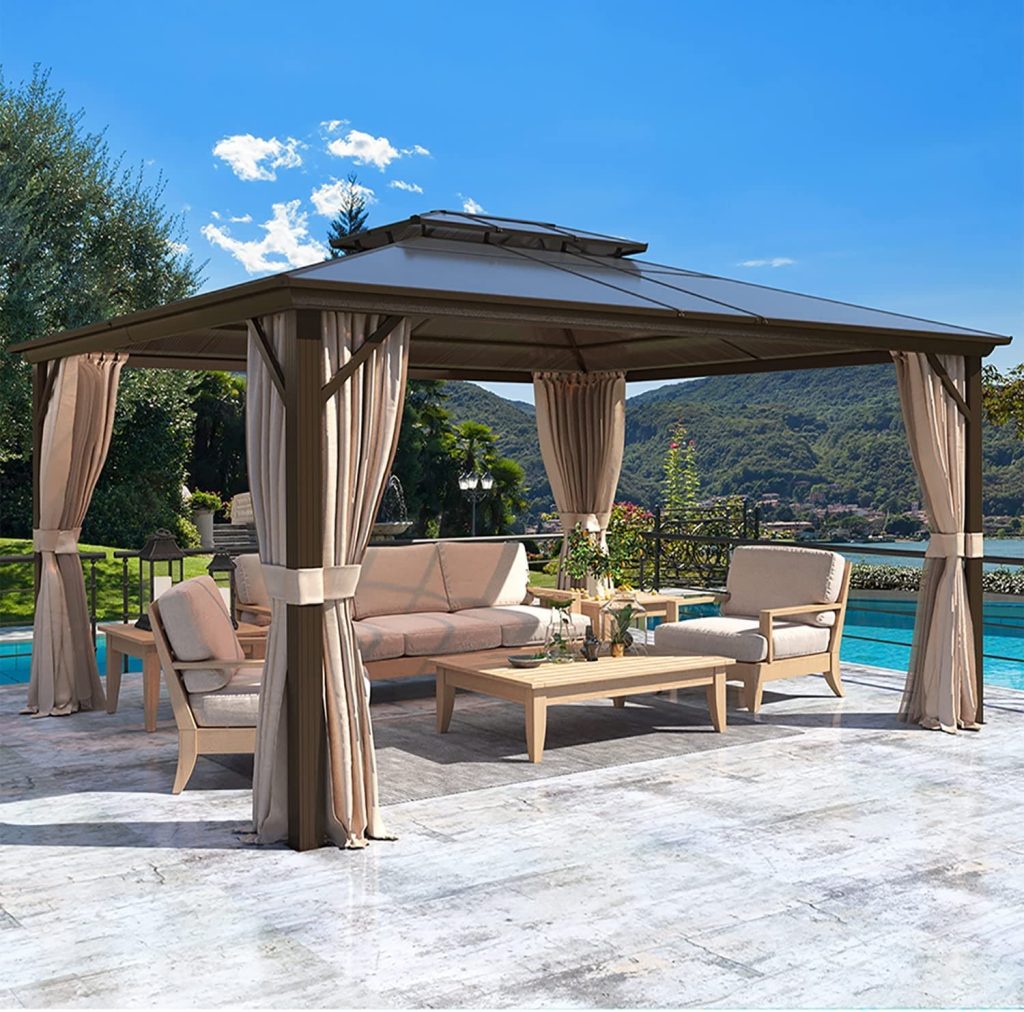
Another important factor in extending the lifespan of your hard top gazebo is protecting it from extreme weather conditions. This can include strong winds, heavy rain, snow, and hail.
One way to protect your hard top gazebo is to use a gazebo cover during harsh weather conditions. A gazebo cover can help prevent damage to the roof and frame from the elements.
In areas with heavy snow loads, it’s important to make sure that the roof of your hard top gazebo is steep enough to prevent snow buildup. A steep roof pitch can help prevent damage from snow accumulation and collapse.
If you live in an area with strong winds, it’s important to ensure your hard top gazebo is properly anchored and secured to the ground. This can include using stakes or anchors to secure the frame and roof panels.
Repainting or Staining the Gazebo:
Over time, the paint or stain on your hard top gazebo may begin to fade or peel. To maintain the appearance of your gazebo and prevent damage from exposure to the elements, it’s important to repaint or stain it periodically.
Before repainting or staining your hard top gazebo, clean it thoroughly and remove any loose paint or stain.
Then, apply a new coat of paint or stain according to the manufacturer’s instructions. This can help protect the wood or metal from moisture, UV rays, and other weather-related damage.
Making Repairs Promptly:
Finally, it’s important to make repairs to your hard top gazebo promptly when issues arise. This can help prevent further damage and extend the lifespan of your gazebo.
If you notice any cracks, rust, or other issues with the frame or roof panels, make sure to address them as soon as possible. You can replace damaged panels, seal cracks, or repaint rusted areas.
It’s also important to inspect the hardware and bolts on your hard-top gazebo regularly. If you notice any loose or missing bolts, replace them promptly to prevent further damage or instability.
When to Replace a Hard Top Gazebo
A hard top gazebo is a great addition to any backyard or outdoor space, providing a comfortable and shaded area for relaxation and entertainment.
However, over time, a hard top gazebo may start to show signs of wear and tear or become damaged beyond repair.
We will discuss when it’s time to replace a hard top gazebo based on three main factors: signs of wear and tear, damage that cannot be repaired, and safety concerns.
Signs of Wear and Tear
One of the main factors to consider when determining whether to replace a hard top gazebo is the level of wear and tear it has endured.
Signs of wear and tear may include rust, fading or discoloration, cracking or warping, and general structure deterioration.
Rust is a common issue for metal gazebos and can be a sign of underlying corrosion that may compromise the structural integrity of the gazebo.
Fading or discoloration may occur over time due to exposure to sunlight and weather conditions. Cracking or warping can be a sign of wood gazebos that have been exposed to moisture or can no longer support the structure’s weight.
If you notice any of these signs of wear and tear, it may be time to consider replacing your hard top gazebo.
Damage that Cannot Be Repaired
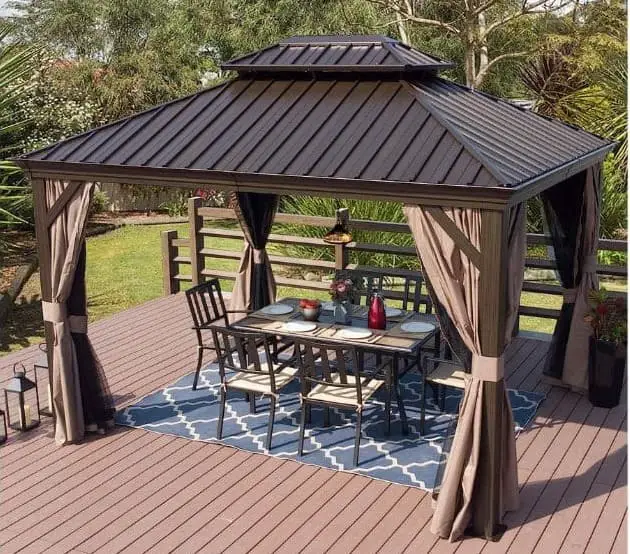
Another factor to consider when deciding whether to replace a hard top gazebo is the level of damage that has occurred and whether it can be repaired.
Small cracks, scratches, and dents can often be repaired, but more significant damage, such as large cracks or holes, severe rust, or structural damage, may be beyond repair.
If the damage is significant and cannot be fixed, it may be necessary to replace the entire gazebo.
Safety Concerns
The safety of your family and guests should always be a top priority when it comes to outdoor structures such as gazebos.
If you notice any safety concerns, such as unstable or wobbly legs, loose or missing screws or bolts, or other structural issues, it may be time to consider replacing your hard top gazebo.
Other safety concerns may include issues with electrical wiring, such as exposed wires or faulty outlets, or signs of mold or mildew that could pose a health risk to you and your guests.
Generally, a well-maintained hard top gazebo can last for many years, but eventually, wear and tear, damage, or safety concerns may require a replacement.
To extend the lifespan of your hard top gazebo, it’s essential to perform regular maintenance such as cleaning, sealing, and repainting as needed.
Additionally, it’s essential to inspect your gazebo regularly for signs of wear and tear, damage, or safety concerns, and to address any issues promptly to avoid further damage or safety risks.
When it’s time to replace your hard top gazebo, consider factors such as material, size, and design to ensure that your new pavilion fits your needs and style preferences.
Look for a high-quality material such as metal, polycarbonate, or wood, and consider features such as built-in lighting, insect screens, or privacy curtains.
By taking the time to carefully choose and maintain your hard top gazebo, you can enjoy a beautiful and functional outdoor space for many years to come.
Maintenance and upkeep for extending the lifespan of a hard top gazebo
Maintenance and upkeep are critical for extending the lifespan of a hard top gazebo.
Proper care ensures that the gazebo remains sturdy, functional, and aesthetically pleasing. Neglecting maintenance can cause damage that may shorten the lifespan of the gazebo.
Here are some essential maintenance and upkeep practices to follow:
Cleaning and removing debris:
Cleaning the hard top gazebo regularly is essential for maintaining its appearance and durability. Debris such as leaves, branches, and dirt can accumulate on the roof and between the panels, which can cause damage if not removed. Use a broom or a blower to remove debris from the roof and panels.
You can also use a pressure washer, but be cautious not to use too much pressure as it can cause damage to the roof or panels. Cleaning the gazebo’s frame is also important, as dirt and grime can cause rusting and discoloration.
Use a soft-bristled brush and a mild detergent to clean the frame, then rinse thoroughly with water.
Repairs and replacements:
Inspect the gazebo regularly for any signs of damage or wear and tear. If you notice any issues, address them promptly to prevent further damage.
Replace any loose or missing bolts, screws, or panels. Cracks or holes in the roof or panels should be sealed immediately to prevent water damage.
Wood gazebos may require regular re-staining or sealing to protect against moisture and UV rays.
Protection from harsh weather conditions:
Extreme weather conditions can cause significant damage to a hard top gazebo, shortening its lifespan. Protect the gazebo by using a gazebo cover during the off-season or when not in use. This can prevent debris from accumulating on the roof and panels and protect against snow, rain, and hail.
Ensure the roof has a steep pitch to prevent snow buildup, which can cause the roof to collapse. Properly anchor the gazebo to the ground to prevent it from toppling over during strong winds or storms.
Overall, proper maintenance and upkeep are essential for extending the lifespan of a hard top gazebo. Regular cleaning and removal of debris, prompt repairs and replacements, and protection from harsh weather conditions can help ensure the gazebo remains functional and aesthetically pleasing for many years to come.
A well-maintained hard top gazebo not only adds value to your property but also provides a beautiful and relaxing outdoor space to enjoy with family and friends.
FAQs
Q.1 What are the main factors that affect the lifespan of a hard top gazebo?
The main factors that affect the lifespan of a hard top gazebo include the material used, climate and weather conditions, maintenance and upkeep, and the quality of installation.
Q.2 Can extreme weather conditions affect the lifespan of a hard top gazebo?
Yes, extreme weather conditions such as strong winds, heavy rain, snow, and hail can cause damage to a hard top gazebo and shorten its lifespan.
Q.3 Is it important to regularly clean and maintain a hard top gazebo?
Yes, regular cleaning and maintenance are essential to extend the lifespan of a hard top gazebo. This includes removing debris, inspecting for damage, and addressing any issues promptly.
Q.4vCan repainting or staining a hard top gazebo help extend its lifespan?
Yes, repainting or staining a hard top gazebo can help protect the wood or metal from moisture, UV rays, and other weather-related damage, which can ultimately extend the lifespan of the gazebo.
Q.5 How can I protect my hard top gazebo from extreme weather conditions?
You can protect your hard top gazebo from extreme weather conditions by using a gazebo cover, ensuring a steep roof pitch to prevent snow buildup, properly anchoring and securing the gazebo to the ground, and addressing any issues promptly.
Q.6 Should I make repairs to my hard top gazebo promptly?
Yes, it’s essential to make repairs to your hard top gazebo promptly to prevent further damage and extend its lifespan. This includes replacing damaged panels, sealing cracks, and replacing loose or missing bolts.
Q.7 What is the average lifespan of a hard top gazebo?
The lifespan of a hard top gazebo can vary depending on several factors, such as the material used, weather conditions, maintenance, and quality of installation. However, on average, a well-maintained hard top gazebo lasts 10 to 20 years.
Conclusion
In conclusion, the lifespan of a hard top gazebo can vary depending on several factors, such as the material used, weather conditions, maintenance and upkeep, and the quality of installation. Metal and polycarbonate hard top gazebos generally have a longer lifespan than wood hard top gazebos.
To extend the lifespan of a hard top gazebo, regular cleaning and maintenance, protecting it from extreme weather conditions, repainting or staining it, and making prompt repairs are important.
Signs of wear and tear, damage that cannot be repaired, and safety concerns are indicators that it may be time to replace a hard top gazebo.
Proper maintenance and upkeep such as cleaning and removing debris, repairs, and replacements, and protection from harsh weather conditions can help extend the lifespan of a hard top gazebo.
We hope this guide helped you understand how long a hard top gazebo can last. If you have any questions, please ask in the comments section below.

